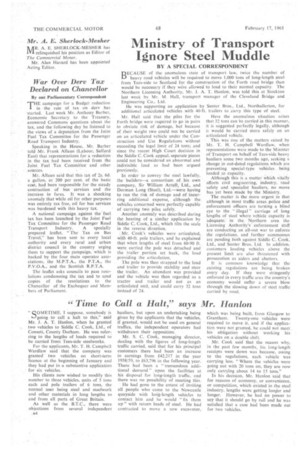Ministry of Transport Ignore Steel Muddle
Page 38

If you've noticed an error in this article please click here to report it so we can fix it.
BY A SPECIAL CORRESPONDENT BECAUSE of the anomalous state of transport law, twice the number of heavy road vehicles will be required to move 1.000 tons of long-length steel from Tees-side to Scotland for the construction of the Forth road bridge than would be necessary if they were allowed to load to their normal capacity. The Northern Licensing Authority, Mr. J. A. T. Hanlon, was told this at Stockton last week by Mr. M. Hall, transport manager of the Cleveland Bridge and Engineering Co., Ltd.
He was supporting an application by Sunter Bros., Ltd., Northallerton, for additional articulated vehicles with 40-ft trailers to carry this type of steel.
Mr. Hall said that the piles for the Forth bridge were required to go in pairs to obviate risk of damage, but because of .their weight two could not be carried on an articulated vehicle under the Construction and Use Regulations without exceeding the legal limit of 24 tons; and since the recent High Court decision in the Siddle C. Cook appeal, separate pieces could not be considered an abnormal and indivisible load as had been argued Previously.
In order to convey the steel lawfully, the builders—a consortium of his own company, Sir William Arroll, Ltd., and Dorman Long (Steel), Ltd.—were having to run the risk of damage and of incurring additional expense, although • the vehicles concerned were perfectly capable of carrying two piles safely. Another anomaly was described during the hearing of a similar application by Siddle C. Cook, Ltd., which tilts the scale in the reverse direction.
Mr. Cook's vehicles were articulated; with 40-ft. pole trailers, and he explained that when lengths of steel from 60-90 ft. were carried the pole was detached and the trailer portion set back, the load providing the articulation. The pole was then strapped to the load and trailer to provide stability and steer the trailer. An attendant was provided and the vehicle was then regarded as a tractor and trailer and not as an articulated unit, and could carry 32 tons instead of 24. Here the anomalous situation arises that 32 tons can be carried in this manner, it is suggested perfectly legally, although it would be carried more safely on an articulated vehicle.
This was one of the matters raised by Mr. T. H. Campbell Wardlaw, when representations were made to the Minister of Transport on behalf of Tees-side heavy hauliers some two months ago, seeking a change in out-dated regulations which are preventing special-type vehicles being loaded to capacity. .
Although this iS a matter Which vitally affects civil engineering; industry, -road safety and -specialist hauliers, no move • has yet been made by the Ministry.
The matter is the more. urgent in that although in most traffic areas police and enforcement officers are turning a blind eye to the " illegal " carriage of long lengths of steel where vehicle capacity is adequate; in the Northern area the Licensing Authority's enforcement staff are conduCting an all-out war to enforce the regulations, and futther summonses are pending both against Siddle C.. Cook. Ltd., and Sunter Bros, Ltd. In addition. customers loading vehicles above the present limit are also threatened with prosecution as aiders and abettors. It is common knowledge that the existing regulations are being broken every day. If they were stringently enforced in every traffic area the country's economy would suffer a severe blow through the slowing down of steel traffic carried by road.




















































































































